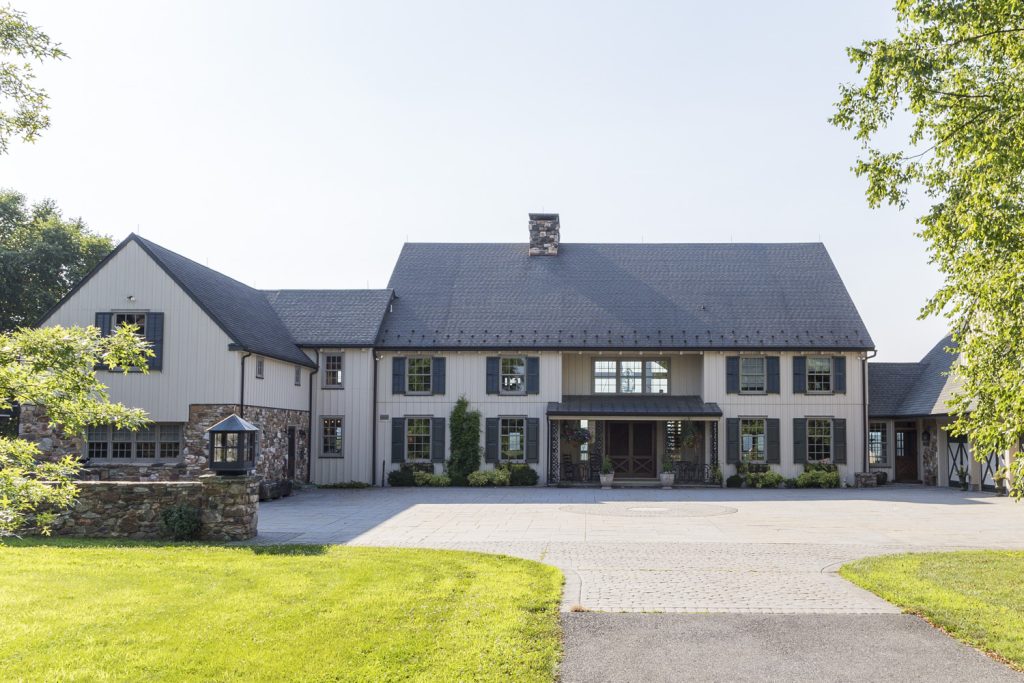Painting your home’s exterior every 5-10 years is an important part of keeping it looking its best. But there’s a lot more to exterior home maintenance than a fresh coat of paint.
Curb appeal matters, even when your home isn’t for sale. People want to be proud of where they live and a well-maintained exterior helps instill that sense of pride. But the never-ending to-do list that comes with homeownership can be overwhelming, unless you have a strategic approach for staying on top of things.
As experienced home finishing professionals in Lancaster, PA, we know what it takes to keep our clients’ exteriors looking exceptional. That’s why we’re sharing our recommendations for what steps you should take, how frequently you should take them, and what to avoid, in order to keep your home looking amazing.
Prestige Painting’s Top 5 Exterior Maintenance Tips

#1 Avoid Mess Where You Can
One of the best things you can do to keep the outside of your home looking great is to head off messes before they happen. That means protecting your home’s surfaces from trapped dirt or excess water that could damage them over time. Place blocks or saucers underneath planters and a grease tray under your grill. Make sure gutters and drains properly flow away from your house. Shovel your deck or patio promptly, rather than allowing snow to accumulate.
If you use sprinklers to water your lawn, be sure they aren’t hitting your home’s porch, deck, or siding. This is especially important if you live in an area, like Lancaster, that has naturally hard water. You’ll also want to avoid allowing your lawn to extend up to your home. Adding a border of landscaping stones will help keep excess moisture away from your foundation.
Allowing any materials to sit on your exterior surfaces for too long can cause damage. Caustic materials, like cleaning agents used on windows, should be thoroughly rinsed off immediately after use. Milder substances like dust and dirt should be removed regularly, as they can cause staining in the long term.
#2 Prioritize Airflow
So you’ve made sure to prevent trapped dirt and excess moisture wherever possible. There’s one more element you need to consider when protecting your home’s exterior: Air. Unlike water and earth (which your surfaces should be protected from as much as possible), you want the outside of your home to get as much air as possible, especially the small, tight spaces, like beneath a porch or deck.
Without proper ventilation, damp conditions develop and your home’s wooden exterior surfaces are at risk of destructive fungi like dry rot. Consistent airflow deprives these organisms of the moist conditions they need to thrive. Keep plants trimmed back from siding, as well as under porches or decks, and make sure outdoor furniture, planters, or hardscaping aren’t blocking the circulation of air through vulnerable areas.
If you’ve done all these things and are still noticing the accumulation of mildew, you may want to consult a professional. Additional measures, like additives that can be mixed with your home’s paint or stain, may be needed.
#3 Don’t Procrastinate on Repairs
Settling, movement, and even cracking is normal for wooden building materials, even ones that are pressure treated. But what might initially seem like a small defect is actually an open door for deterioration. Use wood filler to fix these problems as soon as you notice them, or you’ll risk leaving your wood vulnerable to further damage.
Likewise, damage to your siding, roof, or gutters should be repaired as soon as possible, even if that requires calling in a professional. Small spots of damage, if neglected, can quickly become widespread problems that are expensive to fix.
#4 Inspect & Touch-Up Paint Consistently
Just like you need to watch wood for cracks and splits, it’s important to regularly inspect your paint for defects so they can be addressed as soon as possible. For minor damage or chipping, a proper cleaning and fresh paint should do the trick. For larger problems like excessive peeling, you’ll want to call in a professional who can identify the source of the problem.
Be sure to store leftover paint properly so it’s available for touch ups when you need it. That means wiping the rim of the can clean before sealing it tightly with a rubber mallet (a hammer can warp the edges). Store in a temperate location (extreme heat, cold, or humidity can ruin it) and, when you’re ready to use it again, take it to the hardware store to be shaken so it’s properly mixed before application.
#5 Follow a Maintenance Routine
For most people, sticking to a routine can make a big difference when it comes to staying on top of monotonous tasks. Having a plan or schedule for keeping up with the exterior maintenance of your home helps ensure small problems don’t go unnoticed and become big ones. Here’s what we recommend:

As with so many things, when it comes to maintaining your home an ounce of prevention is worth a pound of cure. If there’s a way to prevent dirt and water from reaching your home’s surfaces in the first place, it should be a priority. After contact has been made, prompt removal and repair is your best bet.
But the very first step to ensuring the longevity of your exterior finishes is proper surface prep before the application of your paint, stain or sealant. For that, we recommend using a trusted professional, like us.
READY FOR EXCEPTIONAL RESULTS?